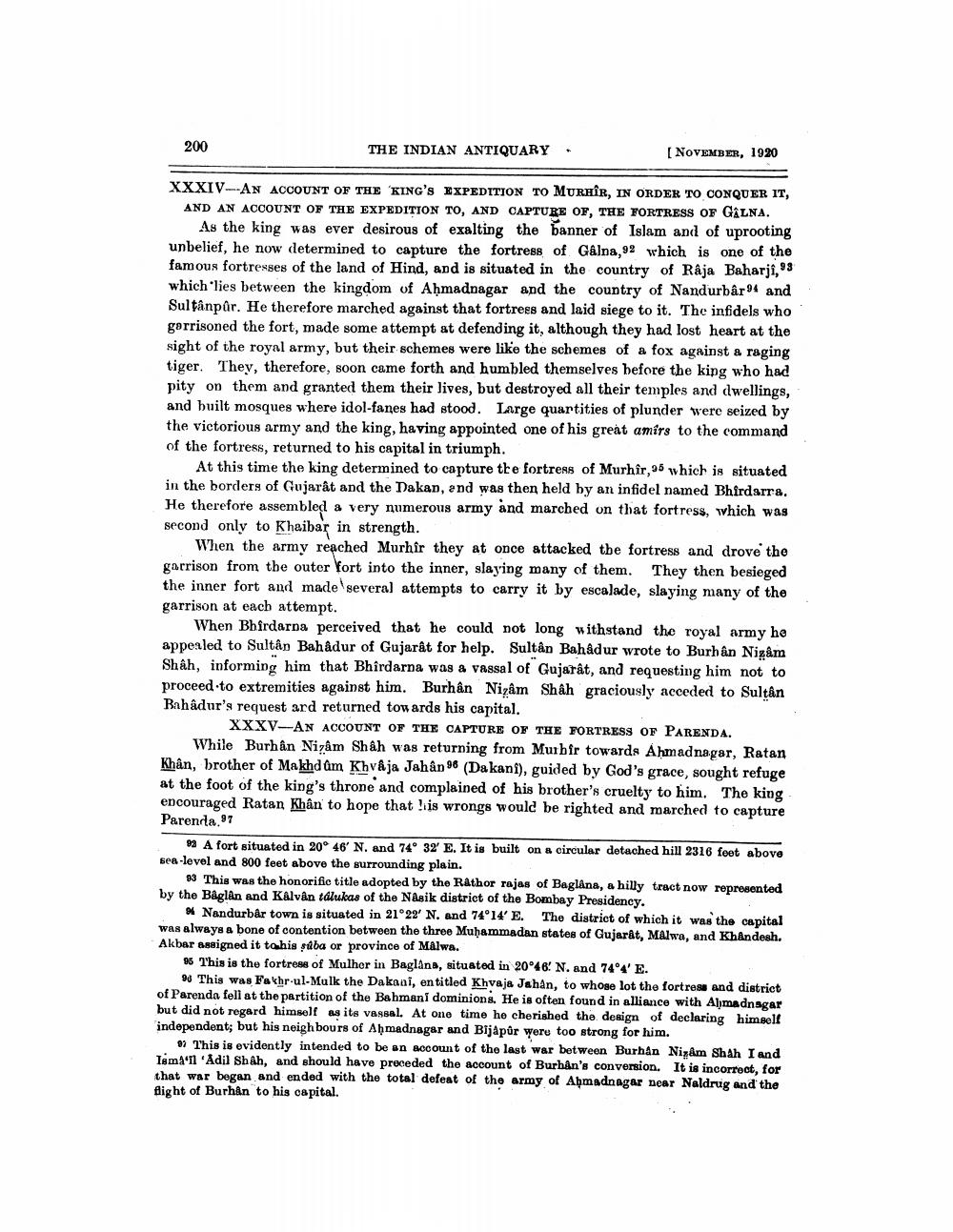________________
200
THE INDIAN ANTIQUARY
[NOVEMBER, 1920
XXXIV-AN ACCOUNT OF THE KING'S EXPEDITION TO MURHÎR, IN ORDER TO CONQUER IT, AND AN ACCOUNT OF THE EXPEDITION TO, AND CAPTURE OF, THE FORTRESS OF GALNA.
As the king was ever desirous of exalting the banner of Islam and of uprooting unbelief, he now determined to capture the fortress of Gâlna,92 which is one of the famous fortresses of the land of Hind, and is situated in the country of Raja Baharjî,93 which lies between the kingdom of Ahmadnagar and the country of Nandurbâr 94 and Sultanpur. He therefore marched against that fortress and laid siege to it. The infidels who garrisoned the fort, made some attempt at defending it, although they had lost heart at the sight of the royal army, but their schemes were like the schemes of a fox against a raging tiger. They, therefore, soon came forth and humbled themselves before the king who had pity on them and granted them their lives, but destroyed all their temples and dwellings, and built mosques where idol-fanes had stood. Large quartities of plunder were seized by the victorious army and the king, having appointed one of his great amirs to the command of the fortress, returned to his capital in triumph.
At this time the king determined to capture the fortress of Murhîr, 95 which is situated in the borders of Gujarât and the Dakan, and was then held by an infidel named Bhirdarra. He therefore assembled a very numerous army and marched on that fortress, which was second only to Khaibar in strength.
When the army reached Murhir they at once attacked the fortress and drove the garrison from the outer fort into the inner, slaying many of them. They then besieged the inner fort and made several attempts to carry it by escalade, slaying many of the garrison at each attempt.
When Bhirdarna perceived that he could not long withstand the royal army he appealed to Sultan Bahâdur of Gujarât for help. Sultan Bahadur wrote to Burhân Nigâm Shah, informing him that Bhîrdarna was a vassal of Gujarât, and requesting him not to proceed to extremities against him. Burhân Nizam Shâh graciously acceded to Sultan Bahadur's request ard returned towards his capital.
XXXV-AN ACCOUNT OF THE CAPTURE OF THE FORTRESS OF PARENDA.
While Burhan Nizam Shah was returning from Murhir towards Ahmadnagar, Ratan Khân, brother of Makhd âm Khvaja Jahân 96 (Dakani), guided by God's grace, sought refuge at the foot of the king's throne and complained of his brother's cruelty to him. The king encouraged Ratan Khân to hope that is wrongs would be righted and marched to capture Parenda.97
93 A fort situated in 20° 46′ N. and 74° 32′ E. It is built on a circular detached hill 2316 feet above sea-level and 800 feet above the surrounding plain.
93 This was the honorific title adopted by the Rathor rajas of Baglâna, a hilly tract now represented by the Baglan and Kalvân tálukas of the Nasik district of the Bombay Presidency.
4 Nandurbar town is situated in 21°22' N. and 74°14' E. The district of which it was the capital was always a bone of contention between the three Muḥammadan states of Gujarat, Malwa, and Khandesh. Akbar assigned it to his suba or province of Malwa.
95 This is the fortress of Mulher in Baglana, situated in 20°46′ N. and 74°4' E.
98 This was Fakhr-ul-Mulk the Dakaai, entitled Khvaja Jahan, to whose lot the fortress and district of Parenda fell at the partition of the Bahmani dominions. He is often found in alliance with Ahmadnagar but did not regard himself as its vassal. At one time he cherished the design of declaring himself independent; but his neighbours of Ahmadnagar and Bijapûr were too strong for him.
This is evidently intended to be an account of the last war between Burhân Nizam Shah I and Isma'Il 'Adil Shah, and should have preceded the account of Burhân's conversion. It is incorrect, for that war began and ended with the total defeat of the army of Ahmadnagar near Naldrug and the flight of Burhan to his capital.




